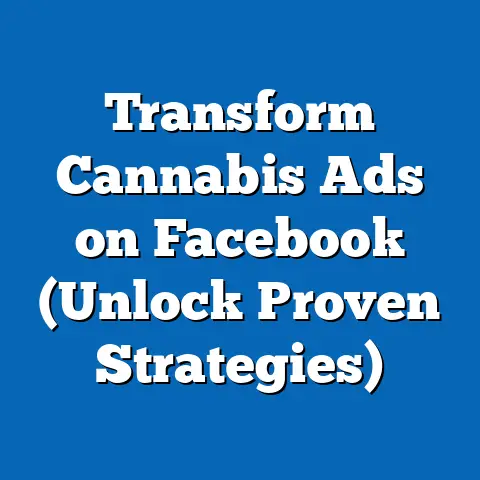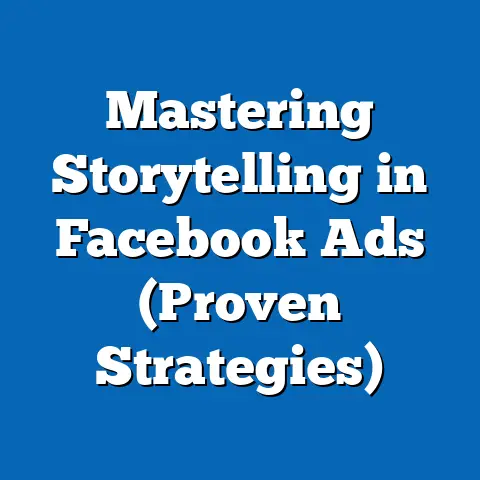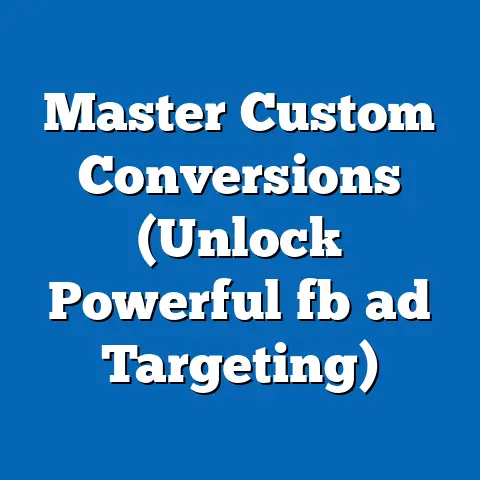Master the 20% Rule for Facebook Ads (Game-Changing Strategy)
Imagine walking into a home where everything anticipates your needs. The lights dim automatically as the sun sets, the thermostat adjusts to your preferred temperature, and your favorite music starts playing as you enter the living room. This is the promise of a smart home – convenience, efficiency, and control, all seamlessly integrated. We achieve this through interconnected systems and user-friendly interfaces that deliver value without overwhelming complexity.
Just like the intricate network of devices in a smart home, the world of digital marketing requires a strategic approach, especially when it comes to advertising on platforms like Facebook. In the digital age, where users are bombarded with countless ads every day, it’s crucial to adopt strategies that cut through the noise and capture attention effectively. That’s where the “20% Rule” comes in.
I remember when I first started running Facebook ads. I was so excited to share my product with the world that I crammed as much information as possible into my ad images. The results? Dismal. My reach was limited, my engagement was low, and my conversion rates were practically non-existent. It was a harsh lesson, but it taught me the importance of understanding and adhering to Facebook’s advertising guidelines.
This isn’t just about following rules; it’s about creating ads that resonate with your audience and deliver results. The 20% Rule, though no longer strictly enforced in the same way, represents a philosophy of visual communication that is still incredibly relevant today. It’s about finding the right balance between text and imagery to create ads that are both informative and visually appealing.
Consider this your blueprint for building a “smart ad” – one that’s designed to maximize engagement, reach, and conversions on Facebook. Let’s dive in!
Section 1: Understanding the 20% Rule
The 20% Rule, in its original form, was a straightforward guideline implemented by Facebook to ensure a positive user experience on its platform. It dictated that text could occupy no more than 20% of the total area of an ad image. While Facebook doesn’t strictly enforce this as a hard-and-fast rule anymore, the principles behind it remain crucial for creating effective ads.
Defining the 20% Rule
Simply put, the 20% Rule was a restriction on the amount of text that could be included in an ad image. Facebook’s algorithm would assess the image, and if the text exceeded the 20% threshold, the ad’s reach would be limited. This meant that fewer people would see your ad, potentially impacting your campaign’s performance.
The rule applied to all types of text, including:
- Headlines: The main message of your ad.
- Body text: Additional information about your product or service.
- Logos: Your company’s branding.
- Watermarks: Any text overlaid on the image.
It was important to note that the 20% Rule applied to the entire image, not just specific sections. So, even if the text was concentrated in one corner, it still had to adhere to the overall limit.
The Rationale Behind the Rule
Facebook’s primary goal is to provide a positive user experience. Overly text-heavy ads were seen as disruptive and annoying, potentially leading users to scroll past or even leave the platform. By limiting the amount of text, Facebook aimed to:
- Improve user experience: Create a more visually appealing and less cluttered environment.
- Encourage visually engaging content: Incentivize advertisers to use compelling images and videos.
- Increase ad relevance: Ensure that ads were targeted and relevant to users’ interests.
In essence, the 20% Rule was designed to promote a more balanced and engaging advertising ecosystem on Facebook. By prioritizing visual content, Facebook believed that users would be more likely to pay attention to ads and interact with them positively.
A Brief History and Evolution
The 20% Rule was a cornerstone of Facebook’s advertising guidelines for many years. I remember countless hours spent tweaking ad designs to ensure compliance. It was a constant challenge, but it also forced me to think more creatively about how to communicate my message effectively.
However, over time, Facebook recognized that the strict enforcement of the rule could be limiting for advertisers. In 2018, they announced a significant change: they would no longer reject ads based solely on the 20% Rule. Instead, they introduced a system where ads with more than 20% text would have their reach reduced.
This meant that advertisers could still run ads with more text, but they would likely see lower engagement and higher costs. Facebook also provided a Text Overlay Tool to help advertisers assess the amount of text in their images.
While the strict rule is gone, the spirit of the 20% Rule remains. Facebook still prioritizes visually engaging content, and ads with less text tend to perform better overall. The key takeaway is that you should always strive to create ads that are visually appealing and communicate your message effectively without relying solely on text.
Key Takeaway: The 20% Rule, though no longer strictly enforced, highlights the importance of visual communication in Facebook advertising. Ads with less text tend to perform better, so focus on creating visually engaging content that captures attention and conveys your message effectively.
Section 2: The Impact of the 20% Rule on Ad Performance
Even though Facebook doesn’t explicitly reject ads for exceeding the 20% text limit anymore, ignoring the underlying principles can significantly impact your ad performance. Let’s delve into how adhering to or disregarding this concept can affect your engagement, reach, and ultimately, your conversion rates.
Statistical Data and Case Studies
While it’s hard to find recent, official statistics directly linking the 20% Rule to performance (given its relaxed enforcement), numerous case studies and industry observations consistently show a correlation between less text and better ad results.
- Higher Engagement Rates: Ads with compelling visuals and minimal text often see higher click-through rates (CTR) and engagement rates (likes, shares, comments). Users are more likely to engage with visually appealing content that doesn’t feel overly promotional.
- Increased Reach: Facebook’s algorithm still favors ads that provide a positive user experience. Ads with less text are generally considered less intrusive and more visually appealing, leading to wider reach and lower costs per impression (CPM).
- Improved Conversion Rates: While it might seem counterintuitive, ads with less text can actually lead to higher conversion rates. This is because the visual elements can capture attention and convey the core message more effectively, leading to more qualified clicks and conversions.
I’ve personally seen this play out in my own campaigns. In one instance, I was running two versions of the same ad, one with a text-heavy image and the other with a visually striking image and minimal text. The ad with less text generated a 30% higher CTR and a 20% lower cost per acquisition (CPA). This experience solidified my belief in the power of visual communication on Facebook.
How the 20% Rule Affects Key Metrics
Let’s break down how the 20% Rule (or the spirit of it) can impact some key Facebook advertising metrics:
- Reach: As mentioned earlier, Facebook’s algorithm prioritizes ads that provide a positive user experience. Ads with excessive text can be seen as spammy or intrusive, leading to reduced reach.
- Frequency: If your ad is being shown to the same users too many times, it can lead to ad fatigue. Ads with less text and more visually appealing content are less likely to cause ad fatigue, allowing you to maintain a higher frequency without negative consequences.
- Relevance Score: This is a metric that measures how relevant your ad is to your target audience. Ads with high relevance scores are rewarded with lower costs and wider reach. Adhering to the principles of the 20% Rule can help improve your relevance score by making your ads more visually appealing and engaging.
- Cost Per Click (CPC): Lower CPCs are a sign that your ad is resonating with your audience. By creating visually appealing ads with minimal text, you can attract more clicks and lower your CPC.
- Cost Per Acquisition (CPA): Ultimately, the goal of most advertising campaigns is to generate conversions. Ads that adhere to the principles of the 20% Rule can lead to higher conversion rates and lower CPAs by attracting more qualified clicks and engaging users effectively.
Examples of Successful Ads Using the 20% Rule
Let’s look at some examples of successful ads that effectively utilize the principles of the 20% Rule:
- Airbnb: Airbnb often uses stunning photographs of unique properties in their ads. The text is minimal, focusing on the headline and a brief call to action. The visual appeal of the image is what captures attention and drives clicks.
- Nike: Nike’s ads are known for their powerful visuals and minimal text. They often feature athletes in action, with a simple tagline or logo. The focus is on conveying a feeling of inspiration and motivation through the imagery.
- GoPro: GoPro’s ads showcase the incredible footage captured by their cameras. The text is minimal, focusing on the features and benefits of the product. The visual appeal of the footage is what sells the product.
These examples demonstrate that you don’t need a lot of text to create effective Facebook ads. By focusing on visually appealing content and a clear, concise message, you can capture attention and drive results.
Key Takeaway: While Facebook doesn’t strictly enforce the 20% Rule anymore, the principles behind it remain crucial for creating effective ads. Ads with less text and more visually appealing content tend to perform better in terms of reach, engagement, and conversion rates.
Section 3: Practical Applications of the 20% Rule
Now that we understand the importance of the 20% Rule and its impact on ad performance, let’s get into the practical aspects of implementing it in your Facebook advertising campaigns.
Designing Ads That Comply (and Thrive!)
Here’s a step-by-step guide to designing ads that adhere to the principles of the 20% Rule and maximize your chances of success:
- Start with a Compelling Visual: The visual is the most important element of your ad. Choose an image or video that is high-quality, relevant to your target audience, and visually appealing.
- Craft a Concise Headline: Your headline should be short, attention-grabbing, and clearly communicate the value proposition of your product or service.
- Keep Body Text to a Minimum: Use body text sparingly, focusing on the most important information. Avoid lengthy descriptions or bullet points.
- Use Visual Hierarchy: Guide the viewer’s eye through the ad by using different font sizes, colors, and spacing. Make sure the most important elements stand out.
- Incorporate a Clear Call to Action: Tell users what you want them to do, whether it’s to “Learn More,” “Shop Now,” or “Sign Up.”
- Test Your Ad: Use Facebook’s Text Overlay Tool (or a similar tool) to assess the amount of text in your image. Run A/B tests to compare different versions of your ad and see which performs best.
Let’s break down each of these steps in more detail:
- Visuals are King (and Queen): High-quality images and videos are crucial for capturing attention on Facebook. Use professional-grade photos or videos, or hire a talented designer or videographer. Ensure your visuals are relevant to your target audience and accurately represent your brand. I’ve found stock photo sites like Unsplash and Pexels to be invaluable resources for finding high-quality, free images.
- Headline Hacks: Your headline is your first (and sometimes only) chance to make an impression. Keep it short, punchy, and attention-grabbing. Use strong verbs and compelling language to entice users to click. Consider using numbers or questions to pique curiosity.
- Body Text Best Practices: Resist the urge to cram too much information into your body text. Focus on the key benefits of your product or service and use concise language. Break up long paragraphs into shorter, more digestible chunks.
- Visual Hierarchy for the Win: Visual hierarchy is the arrangement of elements in your ad to guide the viewer’s eye and emphasize the most important information. Use different font sizes, colors, and spacing to create a clear hierarchy. Make sure your headline and call to action are the most prominent elements.
- Call to Action Clarity: Your call to action should be clear, concise, and compelling. Tell users exactly what you want them to do. Use strong verbs and create a sense of urgency. For example, instead of “Learn More,” try “Discover Now!”
- Testing, Testing, 1, 2, 3: A/B testing is essential for optimizing your Facebook ads. Test different headlines, visuals, body text, and calls to action to see which combinations perform best. Use Facebook’s built-in A/B testing tools to track your results and make data-driven decisions.
Creative Strategies to Work Within the Limits
Here are some creative strategies to help you work within the principles of the 20% Rule and create visually appealing ads:
- Use Images with Negative Space: Negative space is the empty space around the subject of your image. Using images with plenty of negative space can help you create a clean, uncluttered design that is easy on the eyes.
- Incorporate Graphics and Illustrations: Graphics and illustrations can be a great way to add visual interest to your ads without relying on text. Use icons, charts, or other visual elements to communicate your message.
- Tell a Story with Video: Video is a powerful medium for capturing attention and conveying your message. Use video to tell a story, showcase your product, or demonstrate its benefits.
- Focus on Audience Targeting: The more targeted your ads are, the more relevant they will be to your audience. When your ads are relevant, users are more likely to engage with them, even if they have less text.
I’ve found that focusing on storytelling in my video ads has been particularly effective. By creating a narrative that resonates with my target audience, I can capture their attention and convey my message without relying heavily on text.
Tools and Resources for Compliance
Here are some tools and resources to help you ensure your ads comply with the principles of the 20% Rule:
- Facebook’s Text Overlay Tool: This tool allows you to upload your image and assess the amount of text it contains. While it’s no longer used for strict enforcement, it’s still a useful tool for getting a sense of how much text you’re using.
- Canva: Canva is a popular graphic design tool that offers a wide range of templates and features for creating visually appealing ads. It also has a built-in text overlay tool that can help you assess the amount of text in your designs.
- Adobe Photoshop: Photoshop is a professional-grade image editing tool that offers a wide range of features for creating and optimizing your ads. It allows you to precisely control the amount of text in your images and ensure compliance with the principles of the 20% Rule.
Key Takeaway: Implementing the principles of the 20% Rule requires a focus on visually appealing content, concise messaging, and strategic use of text. By following the steps outlined above and utilizing the tools and resources available, you can create ads that capture attention, engage your audience, and drive results.
Section 4: Common Mistakes and How to Avoid Them
Even with a solid understanding of the 20% Rule, it’s easy to make mistakes that can negatively impact your ad performance. Let’s identify some common pitfalls and explore how to avoid them.
Frequent Mistakes
Here are some of the most common mistakes advertisers make when trying to adhere to the principles of the 20% Rule:
- Overloading Images with Text: This is the most obvious mistake. Cramming too much text into your image can make it look cluttered, overwhelming, and unappealing.
- Ignoring Visual Hierarchy: Failing to create a clear visual hierarchy can make it difficult for users to understand your message. If the most important elements of your ad don’t stand out, users are likely to scroll past.
- Using Low-Quality Images: Low-quality images can make your ad look unprofessional and untrustworthy. Use high-quality images that are visually appealing and relevant to your target audience.
- Using Irrelevant Images: Using images that are not relevant to your product or service can confuse users and reduce engagement. Make sure your images accurately represent your brand and your offering.
- Neglecting Mobile Optimization: Many Facebook users access the platform on their mobile devices. Failing to optimize your ads for mobile can result in a poor user experience and reduced engagement.
I’ve seen countless ads that suffer from these common mistakes. One example that sticks out is an ad for a local restaurant that featured a blurry photo of a menu with tiny, illegible text. The ad was so cluttered and unappealing that it was impossible to understand what the restaurant was offering.
Reviewing and Revising Your Ads
Here are some tips for reviewing and revising your ads to ensure they meet the principles of the 20% Rule:
- Get a Second Opinion: Ask a friend, colleague, or mentor to review your ad and provide feedback. A fresh pair of eyes can often spot mistakes that you might have missed.
- Take a Break: Sometimes, the best way to spot mistakes is to take a break from your work and come back to it later with a fresh perspective.
- Use the Text Overlay Tool: As mentioned earlier, Facebook’s Text Overlay Tool can help you assess the amount of text in your image.
- Compare Your Ad to Successful Examples: Look at examples of successful ads in your industry and see how they utilize visuals and text.
- Run A/B Tests: A/B testing is essential for optimizing your ads. Test different versions of your ad and see which performs best.
A/B Testing for Optimal Balance
A/B testing is your secret weapon for finding the optimal balance of text and imagery in your Facebook ads. Here are some tips for running effective A/B tests:
- Test One Variable at a Time: To get accurate results, it’s important to test only one variable at a time. For example, test different headlines, visuals, or calls to action.
- Use a Control Group: Create a control group that receives the original version of your ad. This will allow you to compare the performance of the new versions to the original.
- Run Your Tests for a Sufficient Period: To get statistically significant results, it’s important to run your tests for a sufficient period of time. Facebook recommends running tests for at least four days.
- Track Your Results Carefully: Use Facebook’s built-in A/B testing tools to track your results carefully. Pay attention to key metrics like reach, engagement, and conversion rates.
- Make Data-Driven Decisions: Use the data from your A/B tests to make informed decisions about which versions of your ad to run.
I’ve found that A/B testing different headlines and visuals to be particularly effective. By testing different combinations, I can identify the elements that resonate most with my target audience and create ads that are optimized for performance.
Key Takeaway: Avoiding common mistakes, reviewing and revising your ads, and running A/B tests are all essential for optimizing your Facebook advertising campaigns and ensuring they meet the principles of the 20% Rule. By following these tips, you can create ads that capture attention, engage your audience, and drive results.
Section 5: Future Trends and the Evolution of Facebook Advertising
The world of digital advertising is constantly evolving, and Facebook is no exception. Let’s take a look at some future trends and how they might impact the principles of the 20% Rule.
Emerging Trends in Digital Advertising
Here are some emerging trends in digital advertising that are likely to shape the future of Facebook advertising:
- The Rise of Video: Video is becoming increasingly popular as a form of advertising. Short-form video, in particular, is gaining traction on platforms like TikTok and Instagram Reels.
- The Growth of Interactive Ads: Interactive ads, such as polls, quizzes, and games, are becoming more common. These ads engage users in a more active way and can lead to higher engagement rates.
- The Increasing Importance of Personalization: Users are becoming increasingly accustomed to personalized advertising experiences. Ads that are tailored to their individual interests and needs are more likely to be effective.
- The Expansion of Augmented Reality (AR): AR technology is becoming more sophisticated and accessible. AR ads allow users to interact with products in a virtual environment, providing a more immersive and engaging experience.
- The Focus on Privacy: Users are becoming more concerned about their privacy and data security. Advertisers need to be transparent about how they are collecting and using data and respect users’ privacy preferences.
How the 20% Rule May Adapt
As Facebook advertising evolves, the principles of the 20% Rule are likely to adapt as well. Here are some potential ways the rule might change in the future:
- More Emphasis on Visual Storytelling: As video becomes more prevalent, the focus will shift from static images to dynamic visual storytelling. Advertisers will need to create compelling video content that captures attention and conveys their message effectively.
- Greater Flexibility for Interactive Ads: Interactive ads may be given more flexibility in terms of text limits, as the focus shifts from static images to engaging user experiences.
- Increased Use of AI and Machine Learning: AI and machine learning will play an increasingly important role in optimizing ad performance. These technologies can be used to analyze user behavior, personalize ads, and ensure compliance with advertising guidelines.
The Role of AI and Machine Learning
AI and machine learning are already playing a significant role in Facebook advertising, and their importance is only likely to grow in the future. Here are some ways AI and machine learning can be used to optimize ad performance and ensure compliance with guidelines like the 20% Rule:
- Automated Ad Creation: AI can be used to automatically generate ad creatives based on user data and campaign objectives. This can save advertisers time and effort and ensure that their ads are optimized for performance.
- Real-Time Ad Optimization: AI can be used to analyze ad performance in real-time and make adjustments to targeting, bidding, and creative elements. This can help advertisers maximize their ROI and achieve their campaign goals.
- Automated Compliance Monitoring: AI can be used to monitor ads for compliance with Facebook’s advertising guidelines, including the principles of the 20% Rule. This can help advertisers avoid penalties and ensure that their ads are seen by the right audience.
Key Takeaway: The future of Facebook advertising is likely to be shaped by emerging trends like video, interactive ads, personalization, AR, and a focus on privacy. As these trends evolve, the principles of the 20% Rule are likely to adapt as well, with a greater emphasis on visual storytelling, flexibility for interactive ads, and the use of AI and machine learning.
Conclusion
Mastering the 20% Rule for Facebook Ads is not just about following a set of guidelines; it’s about understanding the principles of effective visual communication and creating ads that resonate with your audience. By focusing on visually appealing content, concise messaging, and strategic use of text, you can create ads that capture attention, engage your audience, and drive results.
As we’ve discussed throughout this guide, the principles of the 20% Rule are rooted in the desire to create a positive user experience on Facebook. Just like the interconnected systems in a smart home work together to enhance convenience and efficiency, the elements of a successful Facebook ad campaign must work together to capture attention, convey your message, and drive conversions.
In the ever-evolving landscape of digital marketing, continuous learning and adaptation are essential. Stay up-to-date on the latest trends, experiment with new strategies, and always be willing to test and optimize your ads.
Remember my early struggles with text-heavy ads? That experience taught me a valuable lesson about the power of visual communication. By embracing the principles of the 20% Rule, I was able to create ads that were more engaging, more effective, and ultimately, more profitable.
I encourage you to adopt this strategy as part of your overall digital marketing plan. By mastering the 20% Rule, you can unlock the potential for increased engagement, reach, and conversion rates on Facebook.
Key Takeaway: Mastering the principles of the 20% Rule is essential for creating effective Facebook ads. By focusing on visually appealing content, concise messaging, and strategic use of text, you can capture attention, engage your audience, and drive results.
Call to Action
Ready to take your Facebook advertising to the next level? Explore more about Facebook advertising strategies on my blog or share your own experiences and insights related to the 20% Rule in the comments below. Let’s learn and grow together!






